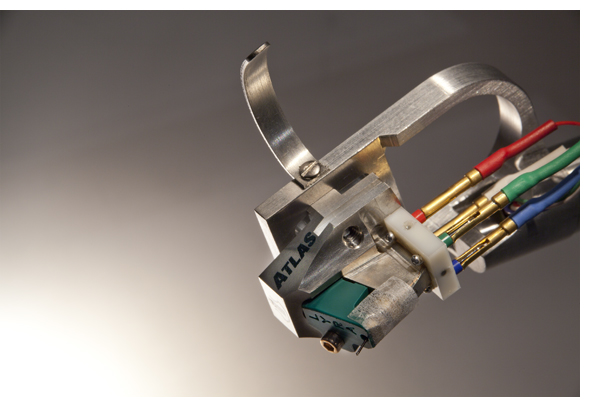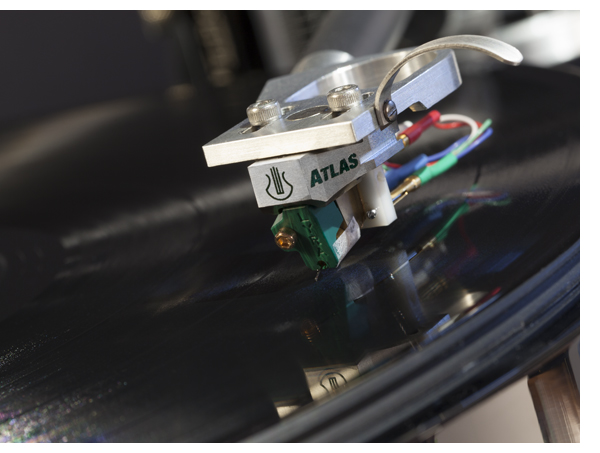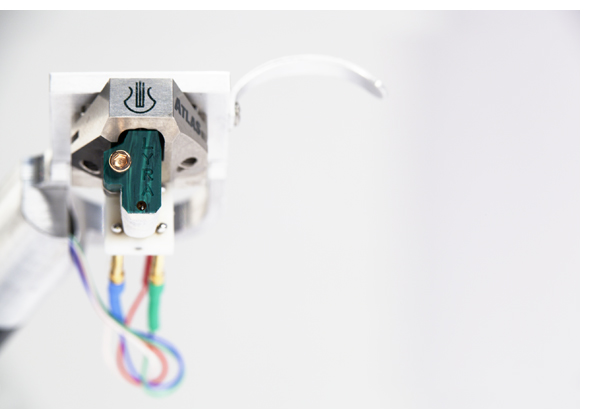Lyra Atlas Cartridge
 Anyone thinking the $9,500 Lyra Atlas merely amounts to high-priced audio jewelry that exceeds a fixed point of diminishing returns couldn’t be more wrong. However, to be put in proper perspective, the cartridge must be evaluated in a high-performance audio system alongside Lyra’s other models—the Titan i and the Kleos. Rather than rely on digital captures or, worse, aural memory, we chose to compare the cartridges side-by-side in identical AVID Acutus Reference SP turntables played through the world-class Vitus MP-P201 phonostage.
Anyone thinking the $9,500 Lyra Atlas merely amounts to high-priced audio jewelry that exceeds a fixed point of diminishing returns couldn’t be more wrong. However, to be put in proper perspective, the cartridge must be evaluated in a high-performance audio system alongside Lyra’s other models—the Titan i and the Kleos. Rather than rely on digital captures or, worse, aural memory, we chose to compare the cartridges side-by-side in identical AVID Acutus Reference SP turntables played through the world-class Vitus MP-P201 phonostage.
Jonathan Carr, responsible for all Lyra cartridge designs, points out that the Atlas’ “new angle” technology actually was introduced on an entry-level cartridge (Delos) and carried forward to the Kleos. Unlike all other MC designs that center the signal coils between the magnets when a cartridge is at rest (and with no load from being placed on a record), new-generation Lyra cartridges achieve optimum alignment between magnet and coil when the cartridge is set down on a record under the load of tracking force. Lyra claims the approach equalizes compliance in both vertical and horizontal planes. In practical terms, the Atlas tracks better than any MC I’ve yet experienced.
Following the lead of the Titan i and legendary Olympos cartridges, the Atlas’ body is machined from pure titanium. Asymmetrical shapes on both the inside and outside further set the Atlas apart from the rest of the Lyra line. Just like a room lacking parallel walls, the dimensions diminish resonances inside the cartridge. Carr mentions that the internal shape of the cartridge requires very complex machining as well, which is accomplished via electric discharge machining, a non-contact process.
The Atlas also delivers 12% more output than previous designs, and does so with 22% less wire in the coils—practically cheating physics. These numbers translate to faster transient response and more accurate reproduction of difficult musical passages. These new coils are now of an X-core design because this gives better channel separation, less crosstalk between channels and lower distortion. Again, Lyra beats the odds with a design that maximizes this design without suffering the loss of dynamics that most cartridges using traditional square core coils.
Speaking fondly of cartridge builder Yoshinori Mishima, who has worked for Lyra for more than two decades, Carr notes: “When I come up with a new design, I like to challenge Mishima to produce something perhaps a bit beyond what he is capable of. As I show him the final design drawings and design prototypes, we discuss what can be done, and if any slight changes must be made. The Atlas is by far the most difficult thing I have asked him to build.”
The Atlas took two years from conception to build. While one of Carr’s intermediate designs did not make it to fruition, it provided knowledge to flesh out the Atlas. “Producing [the concept] cartridge, even though we did not build it, gave me what I needed to take the Titan i to its destination with the Atlas. Without it, I would not have been able to travel the full distance.”
Experience with the Lyra Skala, Argo-I, and Dorian cartridges (confirmed by AudioQuest’s Joe Harley, Lyra’s US importer) suggests orienting the tail of the cartridge body slightly down from the front instead of placing it in the more traditional parallel configuration. The latter arrangement comes across somewhat thin and lacking in body, which has fueled comments stating that Lyra cartridges are highly accurate albeit thin-sounding. No. It’s all in the setup.
Initial listening on the AVID Acutus Reference SP turntable was done with the current Triplanar arm. I performed later comparison tests with identical SME V tonearms and matching Furutech Silver Reference tonearm cables. Optimal tracking force proved to be 1.72 grams in both tonearms—exactly what’s recommended. Lyra suggests a loading range of 104-887 ohms; 1000 ohms is he magic number with the ARC Ref Phono 2SE, and 500 ohms delivers perfection with the Vitus MP-P201 and Pass XP-25 phonostages. Perhaps it’s a tube versus solid-state thing.
Lyra hints that maximum performance requires 30-50 hours, after which the sound smoothes out and noise gets reduced. AudioQuest analog gurus Harley and Shane Buettner corroborate the 30-hour limit. But the cartridge sounds damn good out of the box.
Sound Without Limitations
Technical talk aside, the Atlas succeeds at retrieving more music from the groove than anything I’ve heard. While I am a huge fan of the limited-availability Olympos (reviewed in Issue 17), its richer, nearly romantic sound is not Lyra’s specialty. Carr says, “The Olympos was created for a purpose, with a certain sound in mind. I feel it’s within my rights as a designer to occasionally present a different design exercise. That’s the Olympos; it’s very sexy-sounding.”
As I mention in this issue’s review of the Vitus MP-P201 phonostage (page 121), in order to justify its expense, a component at this price level has to take you on an amazing journey while blazing uncharted territory. The Atlas does so and more. Combining it with the Vitus phonostage makes for almost unworldly sensations. It offers everything: rock-solid imaging, unparalleled dynamics, unmatched tonal accuracy, and exquisite low-level detail retrieval, all created inside a galactic soundfield.
Sure, these characteristics are enough to propel Atlas to the top of the super-cartridge list. But its greatest strength lies in its ability to extract more information from all of your records. Literally, every one you spin. Yes, the most fantastic recordings reveal buried sonic treasures. Still, the Atlas does an equally great job with normal pressings. Spoon’s 2007 album Ga, Ga, Ga, Ga, Ga is a perfect example of a relatively flat indie-rock record that leaves you wondering if analog is worth the bother. The Atlas brings it to life in a way you’d never think possible.
Bruce Springsteen’s new The Wrecking Ball yields similar riches. The CD is highly compressed, and the LP not much better. Enter the Atlas, which pulls every molecule of detail from the grooves while making an otherwise harsh-sounding record enjoyable. Carr underscores that these sorts of hallelujah moments represent his goal with the Atlas, stating, “A high-performance system should increase the number of records you can enjoy on it.”
Much of the newfound resolution can be attributed to the Atlas’ increased tracking; the cartridge passes every tracking torture test with ease. Delighting in my own nerdiness, I chose my Shure TTR-101 test record, the famous “Audio Obstacle Course.” The Atlas effortlessly tracks the toughest passages, a feat I’ve never accomplished with an MC design. And the Kleos proves no slouch in this area, either.
Think of the aforementioned effects as akin to a Formula 1 car coming in for a pit stop. The best drivers hit their marks exactly, while the lesser guys miss the stop by as much as a foot. Not life or death. But as Michael Schumacher’s pit guys once told me, even a small difference cuts down efficiency. While an F1 championship is certainly not on the line while spinning records, the more precisely a stylus can follow the groove, the more accurately the music is rendered, and, the lower the wear is on records.
Unlike a Ferrari that you will only want to take out of the garage on a sunny day, you will want to use the Atlas as a daily driver. Doing so invokes the dreaded subject of cartridge life. Since the company believes that keeping records meticulously clean and paying close attention to the stylus extends life, Lyra includes necessary tools, a stylus brush, LPT stylus treatment with the Atlas. In addition, lowering the cartridge on to the record as gently as possible dramatically extends cartridge life and puts minimal wear on the delicate suspension.
In a perfect world, the Atlas might last 2,500 hours, give or take a few. So, if you listen to three albums a day, every day of the week, the Atlas will last about four years. How many audiophiles keep anything for four years?
A Proper Comparison
Of course, you can’t truly appreciate the Atlas until you compare it to the other two high-end cartridges in Lyra’s lineup. Differences illustrated by my reference system with the Vitus MP-P201 phonostage are not just instantly apparent, they’re major. However, when swapping out the reference components for a much more modest system consisting of the Audio Research PH6 phonostage, AVID Volvere SP turntable, Unison Research S6 amplifier, and Dynaudio Confidence C1 speakers, disparities between the three models are minimal.
Note: If you don’t have a system capable of producing incredible resolution and dynamics, consider sticking with the Delos or Kleos. They offer high performance at a much lower cost, with all the same tonal qualities that make the Atlas and the Titan i stellar. Too often, I’ve seen enthusiastic audiophiles grossly overspend on a mega-bucks cartridge, only to sacrifice resolution elsewhere in the system, and therefore, fail to take full advantage of what a cartridge like the Atlas provides.
Listening to Richard Thompson’s The Old Kit Bag instantly reveals the contrast between the Atlas and Titan i. The latter showcases a more forward tonal balance that might be mistaken for edgy and, when using the Atlas as a direct comparison, slightly thin. The acoustic bass line in “Gethsemane” is well rendered with the Titan i, yet a quick switch to the Atlas gives the song extra weight and a lot more texture. It’s much like going from a zoom lens to a prime lens on a camera; there’s more clarity and tonal purity. With the Atlas, Thompson’s guitar playing locks into place with a precision the Titan i can’t match.
Mobile Fidelity’s reissue of James Taylor’s JT exposes another variation between the two fantastic cartridges. The Titan i possesses more edge sharpness than the Atlas, which at first blush gives the appearance of more resolution. Extended listening shows how much further the Atlas goes into the recording. Anyone who works or plays with Photoshop’s unsharp mask command know this feeling. Used sparingly, the increased edge contrast gives an illusion of sharpness, but pushing it too far gives everything in the photo a surreal, embossed quality.
Instrument decay tells yet another part of the story. The acoustic guitar and cymbals on Taylor’s “There We Are” fade out further, and with more levels of gradation, before going all the way to black with the Atlas. The additional contrast provided by the Titan i, making Taylor’s guitar sound pluckier, may appeal to some. Yet Carly Simon’s backing vocals are almost lost on “Looking for Love on Broadway” when the Titan i is at bat; the Atlas projects them. If the Atlas makes sense for your budget and system, the additional weight and image size—combined with the aforementioned tonal qualities—will take you to a very special place, indeed.
Titan i vs. Kleos
Carr points out that there are some areas in which the Kleos will excel when compared to the Titan. Vide, lower surface noise. Both the Kleos and the Atlas are much more like my favorite Koetsus in the sense that the latter maximizes the musical presentation while minimizing surface noise. Most of my records are in excellent shape, but somehow, with the Titan i, one or two pops always surface. (All of my records are cleaned on the Loricraft before major listening sessions, while the Furutech DeMag and the DeStat further reduce surface anomalies.)
On more modern recordings, the edge in dynamics goes to the Kleos. A direct comparison of Mobile Fidelity’s version of Madeline Peyroux’s Bare Bones illuminates the Kleos’ ability to accelerate faster and stop at the end of notes with greater precision. The Kleos does a better job at capturing a drumhead’s “twack” sound as well as the initial strike of piano keys. There’s energy without any acoustic hangover.
Evaluating identical pressings of Brian Eno’s Ambient 4: On Land favored the Kleos and its weightier presentation. The extra bass grunt adds to the album’s ethereal, spooky feel and the Kleos’ ability to minimize background noise is another plus. Densely packed recordings like Mobile Fidelity’s reissue of Santana’s Abraxas favor the Titan i. Its additional edge contrast digs deeper into the cloudy mix.
Shopping Suggestions
The newer technology present in Lyra’s Delos, Kleos, and Atlas represents a major step forward in analog reproduction by giving more resolution, separation, and dynamics than previous designs—and sacrificing nothing. They are incredibly user-friendly and easy to set up and optimize. An hour spent with analog tools and some careful listening is all that’s required.
The more resolution your system (and analog front end, in particular) can deliver, the more you will be able to hear and appreciate the differences between these cartridges. The Kleos is an excellent model, covering all the bases with a fantastic combination of tonal accuracy and tonal saturation, along with a large presentation and wonderful dynamics. Titan i manages more resolution, adding additional contrast even as it might beget a love/hate situation in certain systems. It also took the most time to set up to perfection. In the end, however, the Atlas is the grail. Once you’ve experienced it, there’s no turning back. – Jeff Dorgay
The Lyra Atlas MSRP: $9,500
The Lyra Titan i MSRP: $5,995
The Lyra Kleos MSRP: $2,995
www.lyraanalog.com
Peripherals
| Turntables | AVID Acutus Reference SP (2) w/SME V TriPlanar and Funk Firm FX•R tonearms AVID Volvere SP (2) w/SME V tonearms |
| Phonostages | Vitus Audio MP-P201 Audio Research REF Phono 2 Pass Labs XP-25 Audio Research PH6 |
| Preamplifier | Audio Research REF5SE Burmester 011 |
| Power Amplifier | Audio Research REF 150 Burmester 911mk. 3 Pass XA200.5s |
| Speakers | GamuT S9 |
| Cable | Shunyata Aurora |
| Tonearm Cable | Furutech AG-12 Furutech Silver Arrow AudioQuest LeoPard |
| Power | Running Springs Dmitri and Maxim |




